EU-CONEXUS EENVIRO Research Conference
Sustainable Solutions for Energy and Environment
From the 29th to the 31st of October 2024, EU-CONEXUS EENVIRO Research Conference titled “Sustainable Solutions for Energy and Environment” will cover the two disciplines from the present to the future. The event will take place in Bucharest, Romania, with the aim of facilitating collaboration between diverse research communities associated with our partner institutions, stakeholders and international partners. In addition, it is also set to boost interdisciplinary research projects.
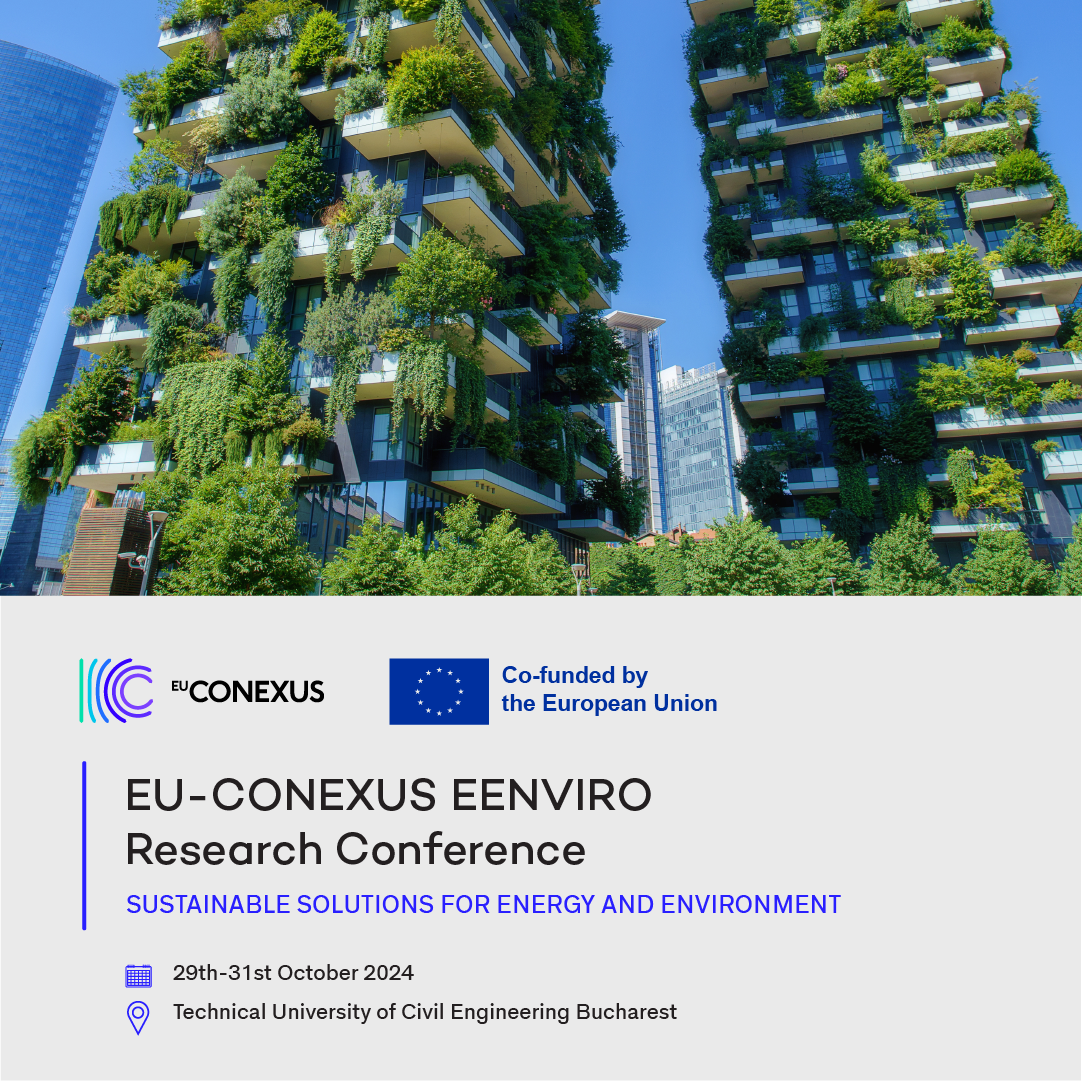
There will be two ways of participating:
– Abstracts
– Articles open to researchers from EU-CONEXUS partner institutions and beyond, as well as international partners. This format will foster collaboration and exchange of knowledge on subjects related to energy and environment from different points of view.
Scientific domains

Coastal and environmental engineering
Topics related to energy and environment located within this domain may concern research and innovations from the field of civil engineering (structural and materials), energy and mechanical engineering, digital solutions and computer science, or marine and environmental engineering. They should all share the purpose of finding solutions for developing sustainable and safer cities, urban infrastructure and resilient buildings.
Environmental sciences and biodiversity
Nature-Based Solutions (NBS) offer innovative approaches to various urban challenges while enhancing sustainability, resilience, and the well-being of city dwellers. Here are several topics for Nature-Based Solutions specifically tailored for urban environments: green infrastructure, natural water management, climate resilience, biodiversity conservation, health and well-being. By integrating these solutions into urban planning and development, cities can create more sustainable, resilient, and liveable environments for their residents while addressing pressing challenges such as climate change, biodiversity loss, and public health concerns.


Life sciences and biotechnology
Recent advances in life sciences and biotechnology towards sustainability and environment protection with a special focus on (but not limited to) biotechnology for environment protection, sustainable agriculture and aquaculture, plants and microorganisms for environment protection and disaster prevention, exploitation of (micro)organisms as biocontrol agents and as sources of new compounds and materials, environment deterioration-related health and disease management in a climate change context, and science applications for eco-friendly energy production.
Social, culture and human sciences institute
Connections between environment and society. Focus on linking scientific knowledge with social, cultural, and ethical insights to deeper understand the complexity and significance of life in connection with energy and environment. Main approaches should address public perception of renewable energy, media representation of environmental issues, social acceptance of green infrastructure, citizen participation in energy projects, environmental justice, energy access and conservation, behavioural economics, cultural and ethical perspectives on environmental protection, historical perspectives on energy transition, eco-friendly accommodation, environmental education, awareness initiatives, psychological empowerment, green finance and investment, intercultural perspectives, eco-linguistics and language in environmental policy.

The deadline for abstract submission has been extended to the 31st of July 2024
Call for abstracts
There will be two ways of participating: only with abstracts, or with papers. Researchers, including young researcher (under the age of 35 years old), are kindly asked to submit their topic abstracts at this link. The deadline for Abstract Submission is the 15th of June.
The event and publication is free of charge for EU-CONEXUS researchers and young researcher (under the age of 35 years old) from 9 partner universities. Researchers coming from outside of EU-CONEXUS are subject to a fee of 300 Euros and young researcher (under the age of 35 years old) coming outside EU-CONEXUS will be subject to a fee of 200 Euros.
For detailed guidelines on abstract submission, please refer to the “Instructions for Abstract Submission”.
Abstracts will be evaluated by our Scientific Committee: to be announced.
Call for Posters
EU-CONEXUS researchers, postdocs, and PhD students are invited to present their research results or showcase their latest research projects through posters, which will be displayed during the Conference on 22-23 October 2025.
Those interested in participating should send their poster abstracts to euconexus@ucv.es, including:
- Poster title
- Indicate your academic position (e.g., PhD candidate, Researcher, Research Staff, Faculty Member, etc.)
- Preferred round table where your poster best belongs:
1️⃣ Data-Driven Decision Making (Smart cities, environmental data and monitoring, AI)
2️⃣ Sustainable Health and Disease Management
3️⃣ Adaptive and Resilient Urban Systems & Smart Infrastructures
4️⃣ Community and Stakeholder Engagement
The posters will facilitate matchmaking and networking for future international collaboration in research projects. Additionally, the most voted poster and the most active voter will receive a prize.
We invite you to submit your poster abstracts by 30 April 2025.
Abstracts will be evaluated by our Scientific Committee, and the selected poster abstracts will be announced on 15 June 2025.
For detailed guidelines on poster abstract submission, please refer to the ‘Instructions for Abstract and Posters Submission’.
Participation in conference
The (co)authors of selected posters will be invited to participate in the conference. Participation is free of charge for EU-CONEXUS universities’ researchers and PhD students. The travel cost can be co-financed by EU-CONEXUS member university (please get in contact with EU-CONEXUS Institutional Coordinator at your university for more details).
The posters will be published by UCV in Valencia. High-resolution images (300 dpi or higher) shall be submitted through abstracts submission platform by 15 September 2025. Further guidelines will be provided.
Publishing of full papers
We call all poster presenters to consider publishing their full papers based on a poster presentation in EU-CONEXUS newly established open access journal Coastal Resilience and Sustainability. It is an interdisciplinary, international, peer-reviewed diamond open access scientific journal. Call for submissions of the full papers will be available on the conference website and more details will be announced during the month of March/April 2025.
Programme
8:00 – 9:00
Registration and coffee
9:00 – 10:30
Keynote Lectures / EU-CONEXUS presentations
10:30 – 11:00
Coffee break
11:00 – 12:30
Presentations/ Workshop
12:30 – 14:00
Lunch
14:00 – 15:30
Presentations/ Workshop
15:30 – 16:00
Coffee break
16:00 – 17:30
Presentations/Posters/Workshop
Cultural or social visit
19:00
Dinner

Laure CASTIN (PhD)
AUF, Europe
Appointed as Regional Director for the Central and Eastern Europe Region at the Agence Universitaire de la Francophonie in September 2024, Laure Castin holds a PhD in Political Science from the University of Paris I Panthéon-Sorbonne and has over thirty years of experience in academia. She specializes in international relations, intercultural management, and training engineering. Throughout her professional career, Mrs. CASTIN has held several key positions, including Director of General Services and Delegate for International Relations at the University of Reims Champagne-Ardenne (France). She has also served as a cultural and cooperation advisor at the French Embassy in Kazakhstan and as a university and scientific cooperation attaché at the French Embassy in China. In addition, she has taught in Russia, Colombia, and France. Her experience has allowed her to develop a deep understanding of the organization, governance, and strategy of both French and international higher education and research institutions.
Keynote lecture on: ,,AUF and the sustainable development goals’’

Tengfei (Tim) ZHANG (Prof.)
Dalian University of Technology, China
Tianjin University. China
Prof. Zhang is from the Department of Civil Engineering, Dalian University of Technology, China. He is also an adjunct professor of School of Environmental Science and Engineering, Tianjin University. His research expertise includes thermo-fluid dynamics in building and aircraft cabin, particle/microbe aerosolization, and moisture transfer. He is the PI of the research projects/subprojects of the national Key Basic Research and Development Program, national Natural Science Foundation of China (NSFC), Boeing Commercial Airplane, COMAC, etc. Dr. Zhang has published more than 100 international journal papers and successfully claimed 22 inventing patents. He received the Chorafas Dissertation award from Switzerland and the most cited article award from the international journal of Building and Environment. His research was once reported by CNN, CNN Headline News, CGTN Europe, and Business Week. He is recognized as a national outstanding young research scholar and a highly cited scholar in China. Prof. Zhang is currently an Editor of Building and Environment and was the President of Healthy Buildings 2023 Asia and Pacific Rim International Conference.
Keynote lecture on: ,,Respiratory infectious transmission risk and its control during air travel’’
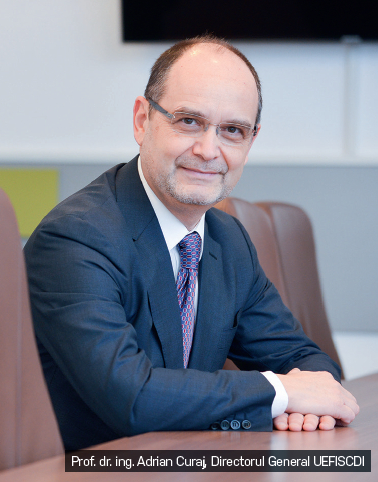
Prof. Adrian CURAJ
UNSTB, Romania
National University of Science and Technology, POLITEHNICA Bucharest, Faculty of Automatic Control and Computers. He chairs the UNESCO Chair for Policies in Science and Innovation at the National School of Political Studies and Public Administration (SNSPA). Since 2010, he has helmed the Executive Agency for Higher Education, Research, Development, and Innovation Funding (UEFISCDI). Curaj served as the Minister of Education in the Cioloș government from November 17, 2015, to July 5, 2016. His academic credentials include a Master’s in Business Administration from the Bucharest Business School (ASEBUSS) in partnership with the University of Washington, Seattle, completed in 2003, and a certificate in Business Administration – Global Management Program, in collaboration with Kennesaw State University. He is a coordinator or consultant on various research and development projects funded by prestigious organizations like the World Bank, UNESCO, UNIDO, the European Training Foundation, and the European Commission. Additionally, Curaj is an active member of several professional associations and foundations, including the Fulbright Commission Steering Committee, the National Commission of Romania for UNESCO, the Romanian Association for the Club of Rome (ARCoR), the Princess Margareta of Romania Foundation, the Romanian Association of Research Managers and Administrators, and EUROSCIENCE.
Keynote lecture on: “Sustainability in Research: Principles and Practices”
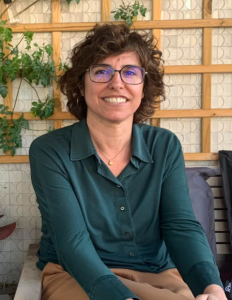
Prof. Elisabet ROCA, PhD.
UPC Barcelona-Tech, Spain
Director of the Research Institute for Sustainability Science and Technology of the Universitat Politècnica de Catalunya (UPC Barcelona-Tech). She is also professor of the Barcelona School of Civil Enginering at UPC. Dr. Roca has dedicated her expertise to the study of coastal sustainability and the social and territorial impacts of engineering interventions. She has participated in several national and international research projects. With many indexed publications in interdisciplinary journals her research addressses the importance of collaboration and holistic thinking to deal with complex contemporary challenges. She has participated in teaching innovation projects with a strong commitment to integrating sustainability competencies into higher education engineering curricula.
Keynote lecture on: “Beyond technological barriers: Fostering social engagement in coastal projects”

Assoc. Prof. Paris FOKAIDES
Frederick University, Cyprus
School of Engineering of Frederick University, Cyprus, and a research mentor at Kaunas University of Technology, Lithuania. In Frederick University, Paris is lecturing the courses of Fluid Mechanics and Heat Transfer at the Department of Mechanical Engineering, as well as the courses of Sustainable Energy Resources, and Energy Design of Buildings in the Masters Programme of Energy Engineering, which he also coordinates. He is also the supervisor of 7 PhD students and 3 PhD graduates.
Paris holds a PhD from the University of Karlsruhe, in Germany in the field of Process Engineering and a Diploma in Mechanical Engineering of Aristotle University in Thessaloniki, Greece. Paris research is mainly related to sustainable energy technologies for the built environment, as well as novel energy related applications in constructions. Paris is involved in research, having actively participated in over 40 research projects related to the field of sustainable built environment over the past 15 years. His research projects are related to the promotion of Industry 4.0 practices for the assessment of the energy performance of the built environment, smart buildings, as well as the field of digitization and analysis of energy related processes. Paris has also served as consultant of the Republic of Cyprus in numerous projects related to the transposition of the European Acquis into the national legislation, in the policy fields of energy, environment and transportation. Paris leads the Sustainable Energy Research Group at Frederick University, an ISO 9000 and 14000 certified self-funded research team consisting of 15 FTE researchers, involved in European and national funded R&I activities. He is also actively involved in the publications section, being Editor in Chief of the International Journal of Sustainable Energy (T&F, Q2) and editorial board member in numerous Q1, Q2 and Q3 Elsevier, Springer, Taylor and Francis and MDPI journals in the field of sustainable energy. As of late 24, Paris has authored and co-authored over 170 Scopus indexed studies, and has an h-index of 34.
Keynote lecture on: “Digital Twins in Coastal Engineering: Pioneering Sustainable Solutions for Environmental Challenges”
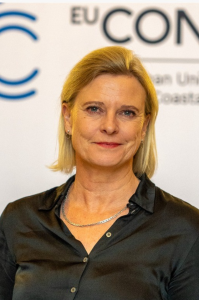
Isabella BAER-EISELT (PhD)
EU-CONEXUS, Europe
Has been Director of the European University for Smart Urban Coastal Sustainability (EU-CONEXUS) since September 2019. She holds a master’s degree in business administration and trade studies and a doctoral degree in political sciences. She has done research on theories of European policies and integration before working for European and international scientific cooperation at Ministries in Austria and France. She was national delegate to various European programme committees for research funding and infrastructures. She has also assisted in setting up collaborative research projects in social sciences and humanities.
Keynote lecture on: ,,Joining Forces for Excellence in Research and Innovation: the EU-CONEXUS Research Area’’
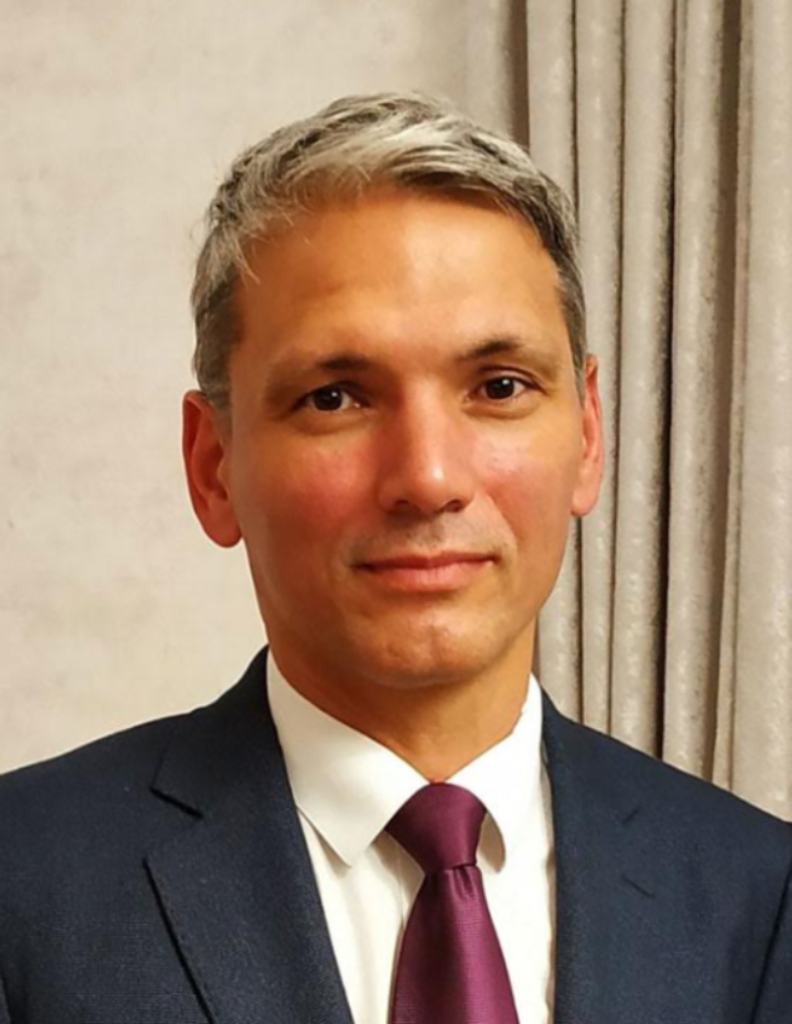
Prof. Yurii HRINCHENKO (PhD)
Odesa I. I. Mechnikov National University, Ukraine
Professor at Odesa I. I. Mechnikov National University, Ukraine, Faculty of Economics and Law, Department of management and business administration. He holds a doctoral degree on economic sciences. He has done research on business ecosystem design and dynamics, including sustainability issues embedded into the business strategy and reginal development policy. He had participated in various projects devoted to promote Industry 4.0 concept into the University curriculum and business practice. He has studied the implications of sustainable development policies on business-government partnership in the field of shaping sustainable economic networks. As the appointee on the position of the head of international relations office of Odesa I. I. Mechnikov National University, initiated the process of the development of the sustainability strategy for the institution, integrating SDG-related issues into the educational and research process, aligning the University research projects within sustainability goals.
Keynote lecture on: ,,Integrating sustainability principles into the curriculum and research: main challenges and possible solutions’’

Prof. Denis WORLANYO AHETO (PhD)
University of Cape Coast, Ghana
is a Professor of Coastal Ecology and Interdisciplinary Oceans Studies and Director of the Centre for Coastal Management – The Africa Centre of Excellence in Coastal Resilience (ACECoR) at the University of Cape Coast. He holds PhD and MSc Degrees in Environmental Sciences and Tropical Aquatic Ecology respectively from the University of Bremen. He also holds MSc. Degree in Rural Development from the Swedish Agricultural University. He earned his BSc (Hons) Degree from the University of Cape Coast. Professor Aheto is a distinguished scholar, with over 15 years of scientific project management experience. He is the authorized representative of institutional donor funded projects in marine/coastal and fisheries management at the University of Cape Coast funded by the World Bank, African Union, USAID, DANIDA among others. He’s passionate about international academic partnerships in his area of professional work. He has outstanding intellectual publication record in indexed journals on issues of coastal/marine ecosystem conservation, small-scale fisheries, marine spatial planning, wetlands ecology, and marine conflict issues. He serves on several national and international Boards including his role as technical advisor to West Africa Coastal Areas Management Program of the World Bank. He holds several meritorious awards for his contributions.

Emmanuel ACHEAMPONG (PhD)
University of Cape Coast, Ghana
holds a PhD. in Natural Science from University of Hamburg in Germany. He was a research fellow for five years – from August, 2007 to December, 2012 – at the Center for Earth System Research and Sustainability (CEN), Hamburg, Germany. CEN is a multi-disciplinary centre made of different institutions with diverse expertise ranging from Fisheries Sciences and Oceanography through to Systems Analysis, Communication and Global Change Governance. Dr. Acheampong was with the Biological Oceanography section of CEN. His post-doctoral research was part of two international (European Union-funded) programmes (MEECE – Marine Ecosystem Evolution in a Changing Environment, and EUROBASIN – European Basin-scale Analysis, Synthesis and INtegration) to resolve the impact of climatic processes on marine ecosystems. Currently, Dr. Acheampong is a senior lecturer at the Department of Fisheries and Aquatic Sciences, University of Cape Coast (UCC), Ghana. He teaches both graduate and undergraduate courses in Oceanography, Coastal Zone Management, Environmental Statistics and Modelling. In addition, Dr Acheampong is the Data Hub and Information Systems Manager of ACECoR – African Centre of Excellence in Coastal Resilience at UCC.
Co-presented Keynote lecture on: ,,Sustainable Marine Fisheries Development Amidst the Strive for Energy Sufficiency in West Africa: The Challenges and Prospects in Ghana’’

Frédéric THEVENET (PhD)
IMT Nord Europe, France
My research activities are based on scientific and technical background linked to material science and physical and chemical characterization of interfaces. This knowledge combined with my interest in environmental issues led me to a PhD thesis on development of heterogeneous air treatment processes: adsorption, photocatalysis and non-thermal plasmas. I subsequently had the opportunity to broaden my field of research to (i) surface reactivity applied to chemical synthesis during my two years of post-doc, and (ii) the analysis of trace gases and indoor air quality upon my arrival at IMT Nord Europe in 2008. From then, I initiated and developed a research axis in this laboratory relating to air treatment and indoor air quality.
After my Habilitation in 2015, I obtained a position as Professor in 2016. In this context, I was (i) able to strengthen my skills in the field of heterogeneous physical chemistry and gas-surface interactions, (ii) develop new innovative experimental instrumentation mainly financed within the framework of partnership and industrial research projects, and (iii) develop the applicability of my research activities, both in the field of heterogeneous atmospheric processes and indoor air quality. This activity is located at the interface between fundamental research and applied research, in order to make these two approaches interact in a positive manner, in direct collaboration with the academic and industrial environments.
From 2019 to 2023, I coordinated the “Indoor Air Quality” research group within IMT Nord Europe. This group brings together 6 teacher-researchers, 3 technicians and on average 8 doctoral students. It aims to enhancing the know-how and skills of IMT Nord Europe in the field of indoor environmental quality. We managed positioning our activities in the national research landscape, and to strengthen the multi-disciplinary nature of our research approaches. It is based on original instrumentation ranging from micro-sensors to large simulation chambers making it possible to reproduce indoor air conditions on a 1:1 scale, including the study of air treatment processes and analytical methods. The activities of this research group receive financial support from public authorities and within the framework of partnership research contracts with the economic and industrial world. Since 2024, I am member of the scientific council of the French Indoor Enviroment Observatory.
Keynote lecture on: “How to move forward in indoor air quality ? Let me introduce you to IRINA.“
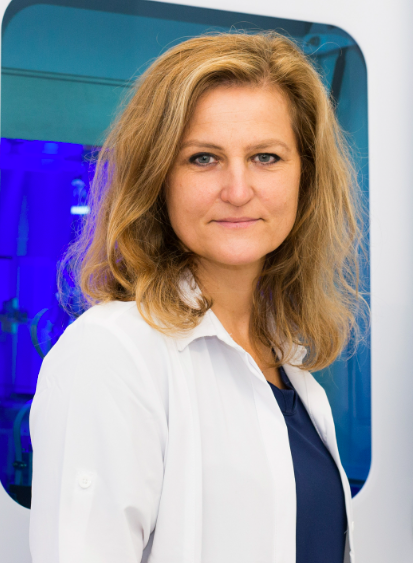
Jūratė Gruodė (Assoc. Prof)
Klaipeda University, Lithuania
Head of the Department of Medical Genetics at Klaipeda University Hospital
Senior researcher of Institute of Health Research and Innovation Science, Klaipeda University.
Jūratė Gruodė, MD, is a clinical geneticist with extensive experience in clinical practice, organizational roles, teaching, research, and management.
With extensive professional experience in patient counseling, hereditary disease diagnosis, identification of targeted therapies, and gene therapy for oncology, neurology, cardiology, obstetrics, and other medical fields, Dr. Jūratė Gruodė has also specialized in molecular diagnostics, particularly of infectious diseases, including viral infections. She consistently follows the latest innovations in genetics and develops diagnostic tools that support personalized medicine for both geneticists and physicians across various specialties.
Dr. Gruodė has over 20 years of teaching experience, including 21 years at Vilnius University and two years at Klaipeda University. Her academic contributions include more than 30 published research papers, as well as active participation in and leadership of scientific projects.
Keynote lecture on: “Environmental and Epigenetic Modifications of the Human Genome: Role in Disease Development.“
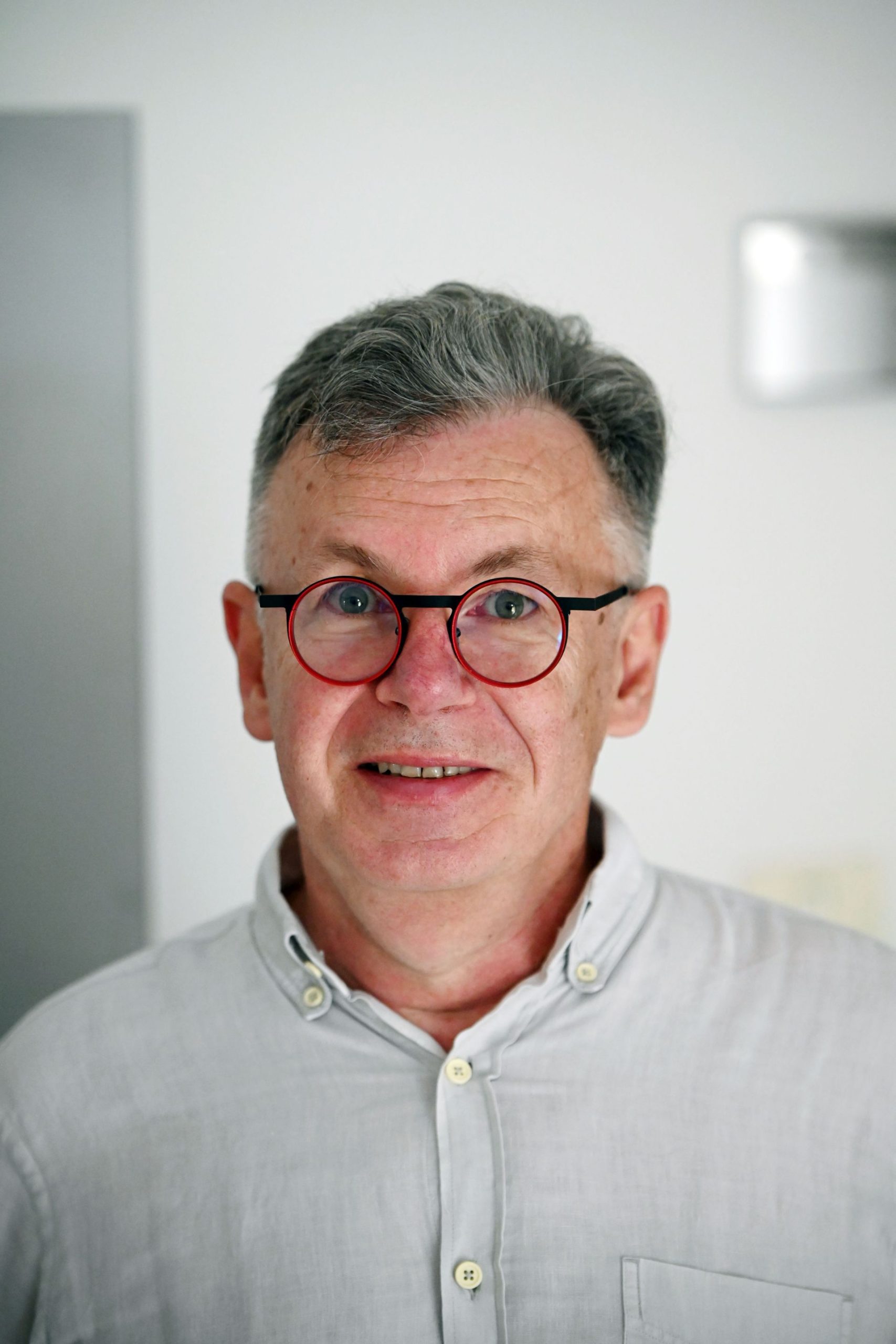
Slaven ZJALIC (Prof)
University of Zadar, Croatia
Department of Ecology, Agronomy and Aquaculture, University of Zadar. He teaches the courses Microbiology, Introduction to Microbial Biotechnology, Food Safety and Mushroom Cultivation at the University of Zadar. His research interest is food safety and in particular the control of mycotoxin presence in food and feed. The focus of his research has been on the use of more environmentally friendly methods to control the presence of mycotoxins in food and feed and food safety in general and reducing the use of chemicals as antifungals. He has participated in numerous national, international and EU research projects, COST Actions and LIFE programmes on food safety, mycotoxin control and food loss management. He has authored or co-authored over 40 indexed scientific papers and 4 books.
Keynote lecture on: “Sustainable methods to maintain food safety in climate changes.“

STANČIENĖ Dalia Marija (Prof)
Klaipeda University, Lithuania
Stančienė D. M. is Habil. Doctor of Humanities (Philosophy) since 2007, a Professor and a Chief Researcher at the Faculty of Health Sciences, Head of the Scientific-Ethical Commission for Biomedical Research at Health Research and Innovation Science Centre of Klaipeda University, an expert of the Lithuanian Bioethics Committee, Member of the Council of Defence of the Doctoral Dissertation of Vytautas Magnus University (Lithuania) in the Field of Humanities (Theology), Editor-in-Chief of the Scientific Journal Logos of Religion, Philosophy, Comparative Cultural Studies and Art (ISSN 0868-7692), Member of Editorial Board of the Journals: „Recherches philosophiques“ of the Catholic Institute of Toulouse, „Sacramentaria & Scienze Religiose“ of the Marchigiano Theological Institute of Ancona, „Religiski-filosofiski raksti” of the Institute of Philosophy and Sociology of Latvia University, „Pedagogy. Social work“ of Uzhhorod National University (Ukraine).
Stančienė has experience in leading academic departments: headed the Department of Philosophy and Cultural Studies at Klaipeda University (10 years), directed Humanities Institute at Mykolas Romeris University (2 years), headed Ethics Department of the Lithuanian Culture Research Institute (4 years). Her academic activities are closely connected with pedagogical work: over 15 years she has been preparing and teaching courses for bachelor’s, master’s in philosophy, phenomenology, cultural philosophy, phenomenology of cultural heritage, medical philosophy, bioethics, supervising the final theses of bachelors, masters and dissertations, participating in dissertation defense committees, as a visiting professor, she lectures at foreign universities. Stančienė’s research is related to historical-humanitarian heritage, history of philosophy, bioethics and social ethics. Scientific research on identity and heritage provided state institutions with scientifically based knowledge about the development of cultural identity in Lithuania, the impact of the challenges of the modern world on social and cultural identity, the nation’s self-awareness. Research results were published at conferences, seminars, and websites.
Keynote lecture on: “Ethnopharmaceutical Heritage for Preservation of the Environment.“
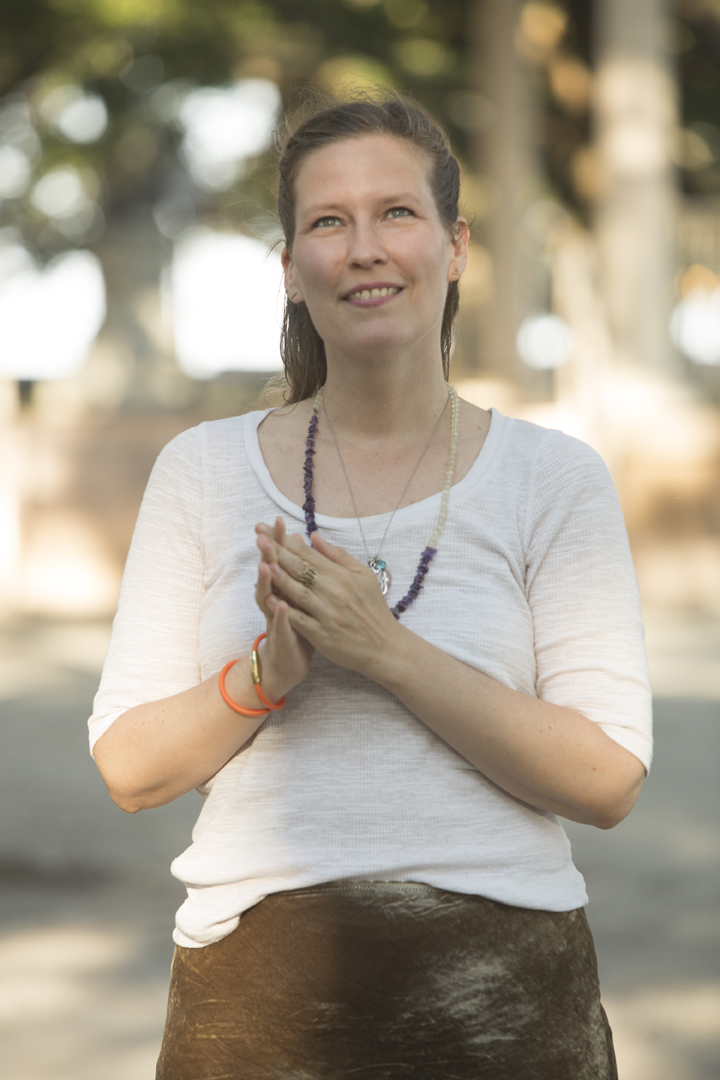
Vanessa Albury
USA
Vanessa Albury is an eco-artist, activist and spiritual coach based in New York City and traveling the world to create healing for people and the planet. She is a 2022 NYFA/ NYSCA Deustche Bank Fellow. Her MFA in Studio Art is from NYU. She is the Founding Artist of Coral Projects, creating the world’s first eco-friendly underwater art exhibition to heal the human-oceans relationship and repopulate filter species. Albury exhibits her sculptural photography, video, ceramics and installation artwork in solo and group shows internationally. Her work has been featured in outlets around the world such as The Guardian, La Repubblica, The Art Newspaper, Hyperallergic, Frieze Magazine, Nylon and Candid Magazine. Recent solos shows include Rewilding a Painted Ocean funded by the Foundation for Contemporary Art, Shadowgraphs (Benrubi Gallery) and Arctic, Future Relics (NurtureArt.) Coral Projects: Everglades Art Lab was a Special Project feature of UNTITLED Art Fair 2019 in Miami presenting a video of site-specific, eco-friendly art installation in the Everglades with the blessing of Miccosukee Reverend Houston Cypress. Her biodegrable, eco-friendy mural Porthole Waves (Svalbard) from Stream to Sea is on view now on Manhattan’s LES. Albury says, “My purpose in this lifetime is for healing for people and the planet through art and the oceans. I was told when I first took a class on the Akashic Records that I’ve been in the records my entire life, I just didn’t always know that and didn’t always welcome it. I now embrace my gifts and guide others in navigating their gifts and healing too, as we all learn how to be better stewards of our only home, planet Earth.
Keynote lecture on: “All Water is One Water: Bringing Science and Sustainability to a Greater Audience the Fun Way, with Art!”
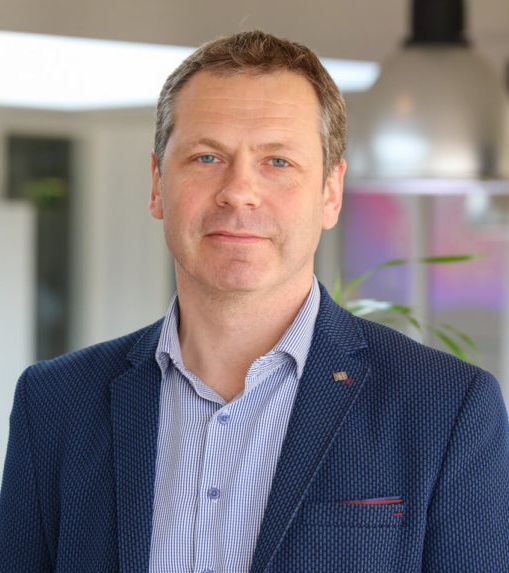
Darius DAUNYS (Phd)
Klaipeda University, Lithuania
Senior Researcher at the Marine Research Institute, Klaipeda University. He holds a PhD in Aquatic Ecology from Klaipeda University and lectures on courses such as Ecology of Marine Landscapes and Habitats, Biostatistics, and Statistical Methods in Marine Ecology for BSc, MSc, and PhD students. His background is in benthic ecology of coastal ecosystems, with a particular focus on the functioning of benthic communities and the role of alien species. Since 2004, he has been a researcher and coordinator of multiple projects addressing various aspects of marine habitat ecology, ranging from inventories and mapping studies of coastal and offshore sites to the development of benthic quality indicators and the designation of marine protected areas and networks in the Baltic, Mediterranean, and Arctic Seas. He has led expert groups for the national implementation of the Water Framework and Marine Strategy Framework Directives. He has also been involved in numerous HELCOM initiatives for the protection of the Baltic Sea and currently leads a research group developing a Management Effectiveness assessment method for the Baltic network of marine protected areas, with the first ecosystem network assessment planned for 2026.
Keynote lecture on: “Evolution of Biodiversity Protection in Coastal Seas: The Case of the Eastern Baltic.”
Arriving
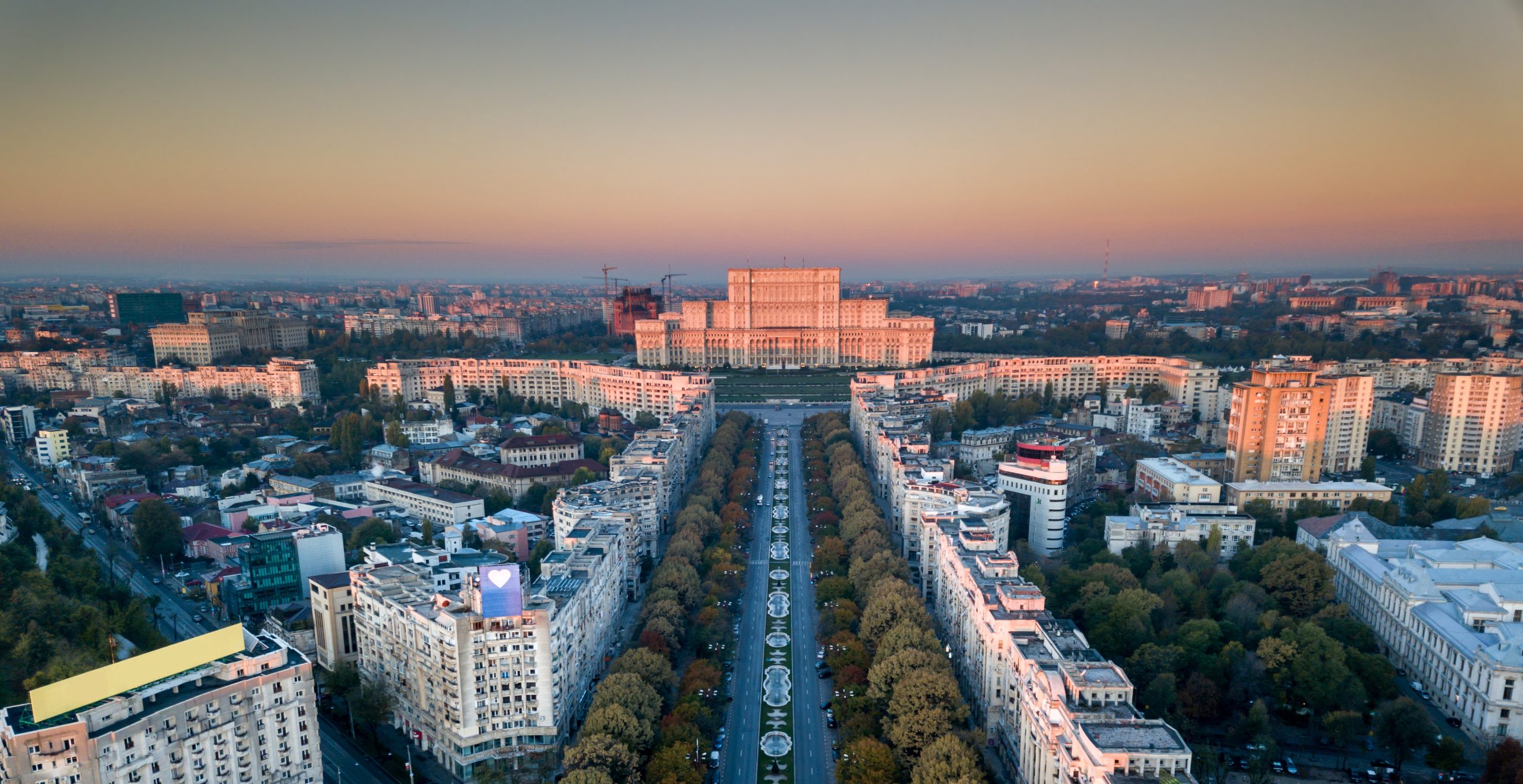
We are delighted to host you at Technical University of Civil Engineering in Bucharest and in Romania! You can find valuable information about the two venues below. For more info, please check our Logistics Memo.
Mission
Starting from the social dimension of higher education and from society’s need to benefit from quality educational and research services in the field of construction to achieve its sustainable development, the fundamental mission assumed by the Technical University of Civil Engineering Bucharest is to be a national centre where new generations of specialists \ receive training and perform scientific research in the field of construction.
Vision
Our vision is to promote excellence in education and research by transforming UTCB into a university of advanced research and education in the field of construction. We also aim to become a landmark and a formidable partner at a national, European, and international level for universities, institutes and centres of research, as well as for the corporate environment for society.
For education, the vision obliges, mainly, the completion of the Bologna process by fully harmonizing bachelor’s, master’s and doctorate studies and their definitive integration into the European area of higher education.
For research, the vision requires the selection and support of priority research directions for UTCB in order to fully integrate into the European research area.
About Bucharest

Bucharest is a city of contrasts, with formidable tourist potential growing from year to year.
Bucharest is Romania`s capital and largest city, as well as the most important industrial and commercial centre in the country. Also, it is one of Europe’s most authentic capitals.
Bucharest is, without a doubt, an unforgettable experience for those who visit it, whether they are city dwellers or tourists. At the level of impressions, things tend to become eclectic, but that is what really arouses the fascination of those who discover the most important attractions to visit in Bucharest.
Interesting facts about Bucharest
It houses the second largest administrative building in the world. While there is a lot of controversy surrounding Bucharest’s Palace of the Parliament, there’s no denying its grandeur. Second only to The Pentagon, its 86m height is also mirrored by a depth of 92m. Boasting nine underground levels, one of which is rumoured to be an atomic bunker, the Palace of the Parliament is one of the heaviest buildings in the world. 95% of materials used in construction were Romanian materials, which was, at the time, a statement of power and Independence, showing that Romania could manage without outside help.
Important buildings are called ‘Palaces’: you’ll find a Palace of the Post Office, Palace of the Telephone Building and Palace of the Bank, just to name a few. The reason for this is one of fashion, as Bucharest took a fancy to the French and adopted much of its mannerisms.
It has its own Arcul de Triumf, mirroring Paris’ most famous monument – the Arc de Triomphe – that honours those who fought and died for France in the French Revolutionary and Napoleonic Wars . When Romania gained its independence in 1878, the wooden structure was erected so that victorious troops could march under it. The arch was rebuilt on the same site in 1922, following World War I. A third structure that’s in place today was built thirteen years later, using Deva granite.
Bucharest had the longest Boulevard in Europe, Bulevardul Unirii. It was communist Romania’s answer to Paris’ Avenue des Champs-Élysées, with a total length of 3,500 m making it 40 m longer than its Paris counterpart. When constructed, its purpose was that of flamboyance, as it was rarely used for transport – unless a VIP was visiting.
Dracula is a myth, but the man he’s based on is real. Vlad the Impaler and Dracula are both nicknames for Vlad III, son of the ruler Vlad Dracul of Wallachia. Vlad Dracul is translated as Vlad the Dragon, who received the name after becoming a member of the Order of the Dragon. The addition of ‘la’ means ‘the son of’, and thus Dracula was born. Whilst Vlad was born in Transylvania, it was custom for the oldest son of the ruler to be raised as tribute to the Ottoman empire of the time, and therefore he was not raised in Transylvania.

